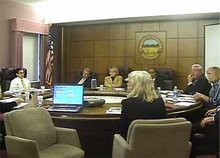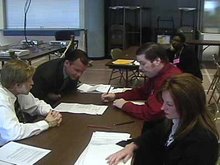Though possibly a baby-step toward thinking about checking their work, and an actual audit – which even the Everest study showed should be mandatory - the CCBOE’s was hardly the “audit” that most people would normally assume.
It was more “a type of” recount, but one that had been actually strategized (though that part of the plan was not shared with witnesses,) to best make sure that the hand counts of each of the 99 precincts selected, would most certainly match the scanner totals – thus avoiding the prospect of having to do a full countywide hand count – and to best assure “success”!
The Directive said if on the second go-round the difference between the handcounts and scan counts was greater than 2 (which after counties got started was announced to have meant 2 per precinct…) a full hand count would have to ensue. (The CCBOE announced after they got started they had changed that to 5 because of their size. I actually thought that change was reasonable among all 7% of Cuyahoga’s 1436 precincts. What was not reasonable was the changing of “audit” “protocols” as workers felt needed, to assure success! - sometimes on the fly, and often not telling anyone.)
So they had the ES&S tech scan one precinct at a time, hardly as in an election environment: and suddenly began calling the M650 scanners, “THE tabulator” when “the tabulator” that was used throughout the election and which prepared the official final results was different software – it was the ES&S Unity software, held on a computer, where after M650 totals had been transferred to ZIP disk, were uploaded and Unity then processed the totals for a report to be printed out.
Though when I could not find the audit supervisor, I appealed to the Deputy Director that regular election software should be checked and used in the audit, and he agreed and told the supervisor to use Unity as the tabulator - after the Deputy Dir. left the warehouse in the morning (it’s not a great place to hang around) and before he returned later in the afternoon, they had begun again using the M650 scanners as the tabulators, printing out the precinct results one at a time from the dot-matrix printers below each scanner. The Deputy Director said nothing about the change. (?)
At the end of this film you’ll hear that interchange, (did not want to stick the camera in people's faces.) At the beginning you’ll see that though audit witnesses were invited to join and take part at 8:30a, the volunteer witnesses sat around wasting time that Tuesday workday morning, as the tech cleaned the scanners (and then they ran the zero reports and a 30-ballot test deck) until well after 10:30a.
You'll also hear both the " we're taking it slow" statement, and "we've got time constraints" statement when it came to uploading results to Unity.
I still wonder why the Unity software was avoided.
(Though it appeared that on the last day they did upload the totals to Unity, you'll be able to see on the final audit film in the next post, and though I've requested that Unity report, as of this date, June 19, I have not received it.)
Another part of the unannounced strategy to assure “audit” “success” was that someone decided that each of the selected precincts must be run on the same scanner that it was run on in the official count. The quote from the audit survey the CCBOE/the audit supervisor (?) sent to the SoS, (received there on May 11) was this suggestion for future audits.
“When using a highspeed OS scanner, the ballots should be scanned on the same unit used during the official canvass. (Example:ES&S M650) This will help with any calibration issues that might occur on units using a legacy type of calibration mechanism.”
(15 of these “legacy” type of calibration mechanisms is what the CCBOE is considering buying right now!)
He said it more clearly, when questioned, at the 5/8/08 board meeting, and which report sound somewhat glowing.
But before moving on to the next post about the audit, (found above,) lets look at the SoS Directive 08-39 re: precinct selection, and the corresponding film.
From the SoS Directive, as confusing and non-random this supposed "random" selection is:
3. The total number of votes cast, in the candidate races and question or issue elections being audited must be compared to the number of voters listed in the poll book, poll list, or signature poll book records by a team of at least two election officials, with each team having an equal numbers of members of the major political parties, including among the election officials conducting the comparison. These records must be available for visual inspection by observers. The observers shall not be permitted to handle the records. (I add, still to this date the poll books have not been reconciled, thus this step did not happen.)
4. Ballots must be checked for proper candidate position and to verify that each candidate's race or a question or issue has been properly identified. Observers may observe the inspection of the ballots.
5. Regular absentee ballot envelopes returned after the statutory deadline may be viewed by the observers. An observer may not see the actual ballot, only the envelopes, which must be sealed. ( I add that the audit supervisor misplaced and included only the last sentence in his incomplete audit plan, regarding Observers being able to see any ballots - again indicating as throughout the counting that he didn't want Observers looking at his ballots.)
6. Ballots must be handled only by the members of the board of elections, its director, deputy director or other designated employees of the board.
7. The Board must randomly select whole precincts whose total equals at least 7% of the total vote.
8. The ballots for these precincts will then be manually hand counted.
9. For the purposes of this directive, "randomly select" means the following:
a. Whole precincts shall be selected for the audit. NOTE: Each precinct's ballots shall include for the audit all relevant regular ballots (VVPAT and/or optical scan paper ballots), provisional ballots, and absentee ballots tallied and recorded as part of the official count. Sealed VVPAT canisters may be opened for the purposes of conducting the post election audit, even if there is not a recount in the precinct.
b. Enough precincts shall be selected for the audit whose total votes cast, when taken together, equal at least 7% of the total votes cast in the election at issue.
c. To select the first precinct for the recount, these steps should be followed:
- Step 1: make an alphabetical list of all the named political subdivisions within the election district or race to be recounted (for example, if a county office race will be recounted, list of all the political subdivisions within the county in
- alphabetical order);
- Step 2: draw, by lot, one of the named political subdivisions from the alphabetical list created in Step 1 ("by lot" means to select one of the political subdivisions randomly, such as by placing all the names from the list in a hat and selecting one);
- Step 3: create a numerical or alphabetical list of all precincts in the political subdivision selected under Step 2 that are within the election district to be recounted;
- Step 4: draw, by lot, one of the precincts from the list created in Step 3. The precinct selected in Step 4 is the first precinct included in the hand recount.
- d. If the precinct selected in Step 4 equals at least 7% of the total votes cast, you are not required to select another precinct for the first manual recount.
- e. If additional precincts are required to reach the 7% threshold, these steps should be followed to select subsequent precincts:
Step 6: determine the next higher precinct number, letter, or combination thereof, if any, after the precinct number selected in Step 4. If there is no next higher precinct number, letter, or combination thereof, choose the first precinct numerically, alphabetically or in combination. This precinct number for the
political subdivision selected in Step 5 will be the next precinct hand counted for the recount.
Step 7: If the two precincts selected from Steps 1 through 6 do not equal at least 7% of the total votes cast in the election at issue, repeat Steps 5 and 6 - using the most recently selected political subdivision and precinct number as the basis for moving sequentially to additional political subdivisions and precincts within those subdivisions - until enough precincts are selected. For example, the third precinct would be from the next political subdivision after the name of the second selected political subdivision on the alphabetical list. The precinct number would be the next higher number, letter, or combination thereof from the precinct number selected for the second political subdivision. Steps 2 through 7 should be repeated sequentially until at least 7% of the total votes cast in the election at issue has been selected. If the board reaches the end of the alphabetical list of political subdivisions or the end of the numerical, alphabetical or combination thereof list of precincts, it shall proceed to the beginning of the list and proceed forward in like manner continuing to use the procedures in Steps 2 through 6.
f. Important Points to Remember: If one precinct has been chosen from each political subdivision in the election district, and the sum of total votes cast remains less than 7% of the total votes cast in the election district, the board shall proceed by continuing to follow the alphabetical list in selecting a political -snip-
Here's film of the beginning of audit precinct selection:
More about"random" audit precinct selection and important counting and ending facts about the Cuyahoga audit in next 2 posts. (Part 2, precinct sampling)






No comments:
Post a Comment